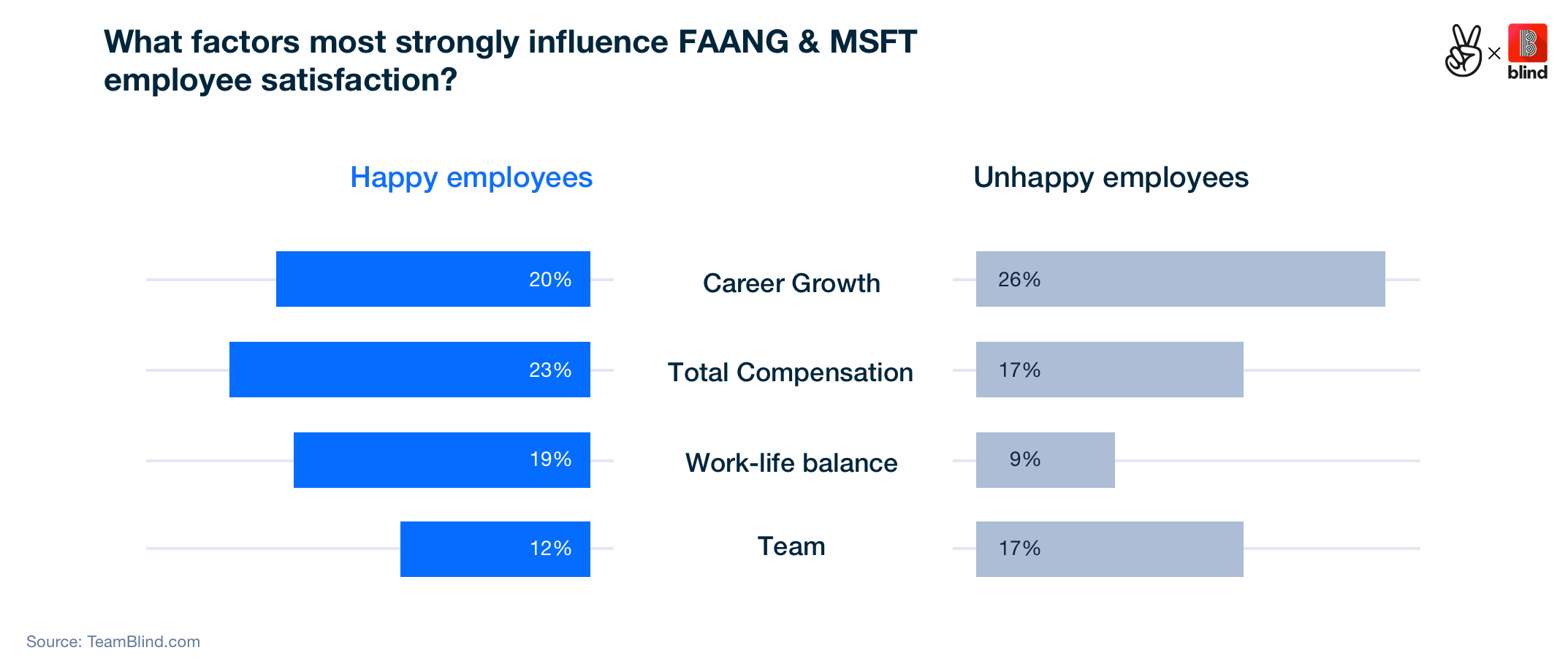Why is there a 32% gap on employee career preferences?
AngelList recently published an article comparing employees at startups against tech giants Facebook, Apple, Amazon, Netflix, Google (FAANG), and Microsoft using the modern version of Juicycampus to see who is happier and why. The conclusions in the article were drawn from Blind, a “trusted online community where more than 2.8 million verified professionals anonymously share advice, provide honest feedback, and discover relevant career information” and AngelList’s own startup survey from 2019. While the article did a nice job drawing comparisons between the two, reading it from a learning nerd perspective showed an incredible preference gradient.
For Learn to Scale who specializes in performance management and career development, the 36% of the first two bars are validation that over a third of startup employees most value skill and career development. Great. Call me.
However, when looking at the second graph through a career growth lens, a gap appears:
Look at that career growth bar. 20% of “happy” employees and 26% of “unhappy” employees at FAANG & Microsoft are motivated by career growth. That’s 46% of employees. AngelList even called career growth out as the most volatile factor in employee happiness. To me, there are some possible conclusions to be drawn.
Startup Employees Will Increasingly Want Career Growth As Organizations Scale
If we isolate “Opportunities to progress” from AngelList’s research and “Career Growth” from Blind, then we see a range of 14% to 46% in employee preferences. Why the 32% gap? Under one hypothesis, it’s reasonable to conclude that startup employees are motivated by a host of factors, not the least being career growth but still a wider range of motivations than a typical tech giant employee. As an organization stabilizes, it either draws employees that prefer clarity in their career or employees’ primary preference shifts from doing-thrilling-today-work to building-a-career-of-tomorrow as their organization balloons.
In either case, it would be wise for a growing startup to increasingly develop their career offerings as their organization matures to keep pace with evolving employee preferences.
Career Options Shape Employee Preferences
Flipping the cause and effect of employee preferences and employer offerings, it’s plausible that the mere existence of multiple career paths makes employees care about it more. The hypothesis here is that a large tech company’s career pathing execution determine if employees are happier. Follow me on this:
As organizations grow and develop more roles, management opportunities, and specialization opportunities, employers naturally need to explain how the roles connect and differ.
If a business has an Engineer I position and an Engineer II position, they will have to draw a line between who is level I and who is level II, as well as reasonably articulate how to move from one level to the next.
That “drawing a line” decision process will need to be done again and again across the business in various contexts:
What differentiates a Manager from a Director? (seniority)
What differentiates a Sales Account Executive from an Enterprise Sales Account Executive? (specialization)
What differentiates a Marketing Manager from a Technical Support Manager? (parity)
The consistency and perceived fairness- or lack thereof- will determine if employees think “career growth” at their company is done well or done poorly.
Employees who trust the process and see themselves benefiting from it will be happier. Alternatively, if the system seems rigged or impossible to navigate, employees will be unhappy and more willing to find a game they can win.
In this hypothesis, career pathing is a given but handling it well separates the retained employee from the job-seeking employee. This reinforces the outcome from the prior example: it is wise for a growing startup to develop their career offerings and to do it really well.
Odds Are It’s Both But Employees Don’t Know How to Voice It
Let’s be real, it’s probably both. An employee can both intrinsically care about their career momentum as well as be delighted by a fair and pragmatic career path. Some people will come to a company strongly motivated by their own vision, some people will sink into the flow of work and find pleasure that their career moves forward simply because they’re doing what they love, and some may not be able to articulate their motivation but feel a need to move up/make more money/manage more people/etc and are happier when both motivations are satisfied.
For a younger workforce, there’s probably a larger bracket of the “I don’t know what it is but I want it” simply because they haven’t had the experience to put words to feelings. You could draw the conclusion that startups draw this population more, but that’s a red herring: all generations have people who feel the pressure to progress but don’t know exactly what drives them. In fact, most peoples’ preferences shift through their life and may not have a clear read on where those preferences sit at one moment (or survey question) in time.
Regardless, companies need to prepare for both by building smart career ladders that any employee feels able to climb. Especially for companies that are defining new roles as they quickly grow, career pathing could turn into a chute that erodes employee retention. An organization like Learn to Scale can help advise you on how to build your pathways or at least assess if there’s inconsistency down the road as you scale. In the meantime, plan for promotion.









